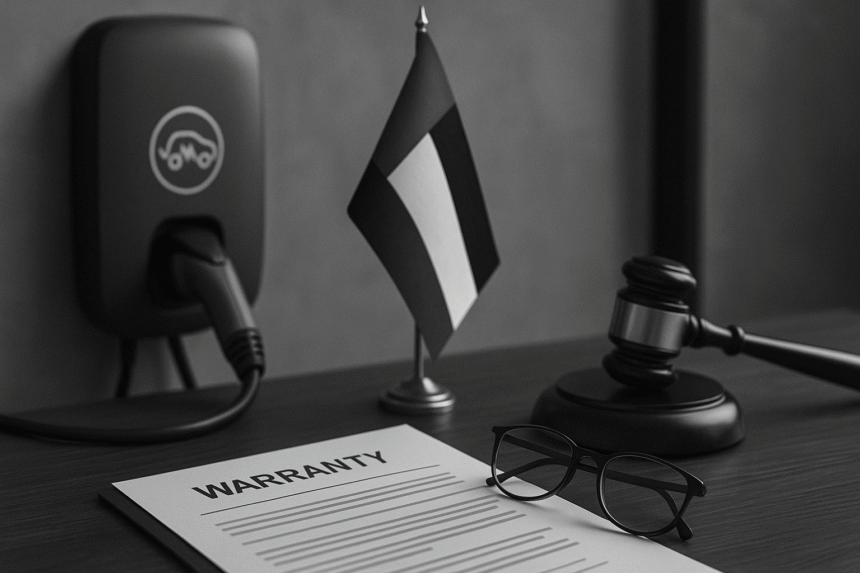How We Helped an EV Infrastructure Provider Draft a Warranty Letter for Clarity and Compliance
As electric vehicle (EV) adoption grows across the Middle East, infrastructure providers are working hard to build reliable charging networks. But with growth comes legal complexity—especially when it comes to warranties.
In this article, I’ll walk you through how we supported an EV infrastructure provider in preparing a clear, legally sound warranty cover letter for their EV charger clients, aligning it with manufacturer warranties while protecting the service provider’s responsibilities.
This is more than a drafting exercise—it’s about translating technical and legal content into client-friendly language that avoids disputes.
Understanding the Background: Manufacturer vs. Installer Roles
Our client, a leading EV infrastructure provider in the UAE, sources AC chargers from a well-known European manufacturer (e.g., EVBox). While the manufacturer provides a standard warranty, it only covers:
- Internal hardware components
- Replacement of defective parts
- Manufacturing-related failures
However, the EV infrastructure provider handles:
- Installation
- On-site inspection
- Commissioning
- Ongoing technical support
These services are not covered by the manufacturer’s warranty—yet most clients assume otherwise.
This gap was creating confusion and service friction.
Why a Warranty Cover Letter Was Needed
Clients often called for free site visits long after installation, expecting “everything” to be under warranty. But without proper documentation, it was difficult for our client to:
- Clarify service boundaries
- Charge fairly for non-covered visits
- Manage client expectations post-installation
We needed to create a document that:
- Accompanies the manufacturer’s warranty
- Clearly defines what is and isn’t covered
- States the timeline for both equipment and service warranties
- Is easy to understand
Key Clauses We Included in the Warranty Letter
We structured the cover letter in a way that balanced clarity with legal coverage. Here are the main sections:
1. EV Charger Details
- Model and serial number
- Manufacturing and installation dates
- Commissioning date (warranty start)
2. Warranty Periods
- Manufacturer’s warranty: typically three years
- Installation service warranty: limited to six months from commissioning
This helped clients understand that labor and support post-six months is chargeable.
3. Scope of Manufacturer Warranty
- Covers internal components only
- Excludes wear-and-tear items (e.g., cables)
- Any tampering voids the warranty
We referred to the official manufacturer warranty booklet and attached it as an annex.
4. Scope of Service Warranty
- Covers labor for initial installation only
- Commissioning, testing, and setup
- Excludes post-installation site visits unless fault is linked to original workmanship
5. Exclusions and Service Charges
We listed situations where the warranty does not apply:
- Cable damage
- Improper use
- Water ingress due to external conditions
- Electrical issues not caused by the unit
It also mentioned that any post-installation visit requested by the client would be subject to a service fee, unless a separate support agreement is signed.
6. Optional Add-On: Maintenance Agreement
We added a call-to-action for clients to opt into a paid service plan if they want extended support.
Writing in Plain English: Translating Legal to Client Language
Many legal documents sound intimidating. We ensured this letter was written in plain English, with:
- Clear headers
- Short paragraphs
- Bullet points
- Simple definitions
For example, instead of saying “This warranty shall be nullified in the event of unauthorized servicing,” we wrote:
“If someone else tries to open or fix the charger, the warranty will no longer apply.”
We also replaced legal jargon like “hereinafter referred to as” with “from now on, we’ll call this the EV Charger.”
Attaching the Manufacturer Warranty File
To avoid duplication or contradiction, we referenced the official manufacturer warranty (as provided in the box with the charger), and made it part of the package:
“This letter does not replace the manufacturer’s warranty. It adds service-related information to help you understand how support works.”
This reinforced transparency.
The Result: Clarity, Professionalism, and Reduced Disputes
After we finalized the warranty letter, the EV infrastructure provider included it with every new installation. The results:
- Clients were better informed and more respectful of the provider’s time
- Service teams spent less time explaining policies on-site
- Additional paid support contracts were signed by clients needing more help
Legal drafting isn’t always about laws—it’s about communication.
Conclusion
If you’re an EV infrastructure provider (or any service business dealing with third-party hardware), you need a warranty cover letter to protect your team and keep your clients informed.
Your legal documents should do more than check boxes—they should communicate clearly, align with third-party warranties, and outline your responsibilities. That’s how you avoid conflict, maintain professionalism, and scale efficiently.
Need help drafting yours? Start with a checklist of what you do (and don’t) cover—and then turn that into a client-friendly legal document.



Leave a Reply